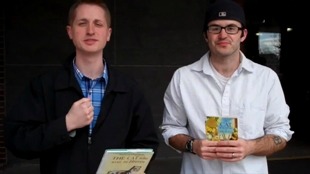By Laura B. Weiss
Who wouldn’t love reading Newbery Medal-winning books? Well, the recently created online Nerdbery Challenge is revealing that some of the prize winners may not be so loveable after all.
At least that’s the view of a school librarian and a fourth-grade teacher who’ve created the Nerdbery contest (#nerdbery). The two men have called on librarians, authors, and teachers to read every single Newbery Medal winner since the award’s inception in 1922.
Unfortunately, the books tackled at the beginning of the challenge—the first set of winners date from the 1920s—have been a bit of a slog to get through. (See below for a complete list of the 1920s winners.)

John Schumacher (left) and Colby Sharp
“The early books are really, really rough,” Oakbrook, IL, school librarian John Schumacher, who conceived the project, said in an interview. “They’re completely dreadful. They’re racist. They’re really boring. They’re really long. They’re just not very good.”
The reading group recently read the 1932 winner, Waterless Mountain (Longmans) by Laura Adams Armer. For the most part, “things are looking up” now that the group is making its way through the 1930s titles, Schumacher wrote in an email.
Launched in late January by Schumacher and Colby Sharp, a fourth-grade teacher from Battle Creek, MI, the multimedia reading marathon, using Twitter, YouTube, and blogs, has attracted about 50 participants.
Newbery challenges are nothing new. Search Google for the term and you’ll come up with page after page of results. But this latest contest involves the adept use of multimedia tools, such as Twitter and video, to engage participants, plus a willingness among Nerdbery readers to take an unvarnished look at iconic titles from years past.
One of the chief ways the two men try to engage readers are with chatty videos that each produces weekly. In the short films, Schumacher and Sharp speak to one another, and to their hardy band of readers, about the week’s pick. But the books themselves often take a backseat to delightful glimpses of Schumacher and Sharp’s day-to-day comings and goings.
In one production, Schumacher films himself behind the wheel of his car as he commutes on Interstate 88 to his school located west of Chicago. The view is through a dirt-and-oil-streaked windshield. Semis whiz by. Cars change lanes. At one point, we catch a quick glimpse of books stacked precariously on the passenger seat.
“Those of you worried about me filming and driving, please don’t worry,” Schumacher reassures his viewers.
Finally, he gets to the book itself, Charles Finger’s Tales from Silverlands (Doubleday), the 1925 Newbery Medal winner. It’s a collection of 19 folktales, which Finger discovered during his travels in South America. Schumacher’s judgment of this hoary tome?
“It’s not the worst Newbery we’ve read so far, Mr. Sharp,” he says, addressing his comrade in Michigan. “Maybe the second worst.” (The worst, according to the librarian, was Hendrik Willem van Loon’s The Story of Mankind [Liveright], the 1922 winner.)
Reaction from Nerdbery Tweeters to the 1920s titles appear to be mixed. Hugh Lofting’s The Voyages of Doctor Dolittle (Stokes) is a favorite. But for the most part, the early awardees haven’t won too many fans.
For instance, Nerdbery participant Donalyn Miller (@donalynbooks) tweeted, “Tales from Silver Lands + treadmill = torture.”
“The 20s have been a little hard to take,” agrees Crystal Brunelle a library media specialist at an elementary school in Onalaska, WI. “The boredom factor is pretty high on some of them,” she wrote in an email.
Still, some participants grudgingly handed out praise for an occasional selection.
Susan Polos (@spolos) tweeted, “I liked Shen of the Sea. Maybe all of the stories weren’t read-aloud wonderful but I liked it.”
In the end, conquering the Newbery list isn’t necessarily the only thing that motivates readers. “The best part is that there are quite a few of us working through it at the same time and sharing the experience,” says Brunelle.
Newbery Medal winners from the 1920s:
1922: The Story of Mankind (Liveright) by Hendrik Willem van Loon
1923: The Voyages of Doctor Dolittle (Stokes) by Hugh Lofting
1924: The Dark Frigate (Little, Brown) by Charles Hawes
1925: Tales from Silver Lands (Doubleday) by Charles Finger
1926: Shen of the Sea (Dutton) by Arthur Bowie Chrisman
1927: Smoky, the Cowhorse (Scribner) by Will James
1928: Gay Neck, the Story of a Pigeon (Dutton) by Dhan Gopal Mukerji
1929: The Trumpeter of Krakow (Macmillan) by Eric P. Kelly


This is a great project! I think it will be interesting to see the shift in the writing as the years go by.
Are there any archives of reviews or critique of those 1920s books? What made a book a good book in 1925? Why doesn’t it translate today? Is the book bad or has the time/space continuum made us incapable of detecting good literature? What if it’s us? OMG. Would “Dead End in Norvelt” be mocked in 1922?
This project sounds fun! Maybe these guys should sit with the folks who actually vote on the Newbery. In my opinion, the books chosen to win the Newbery over the last 15 years are not good or relevant. I can only guess that the committee is out of touch with what young adults are actually reading.
Please re-read the criteria for the Newbery award. It’s for the “most distinguished book published” … for children “up to age 14.” It’s not an award for Young Adults.
I’m not sure how useful reading those books is towards the goal of serving today’s young readers, but it sounds like an interesting project.
As for notafan the award isn’t for popularity, it’s for literary merit. We don’t need to single out the popular, the NYT, goodreads, and amazon are more than happy to help us there. There is still value in having experts on children’s literature recognize excellence. Besides, you’d be amazed at what kids and teens will read with a good booktalk.